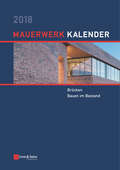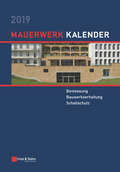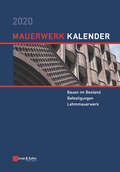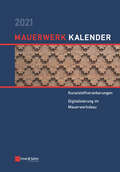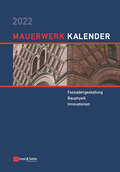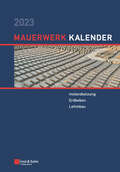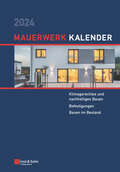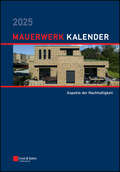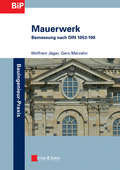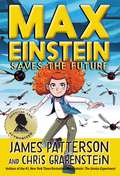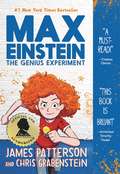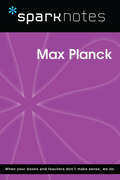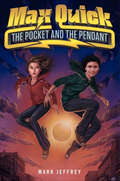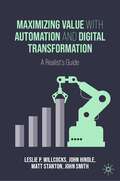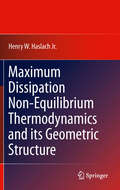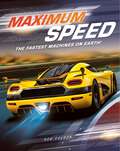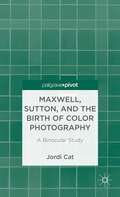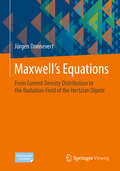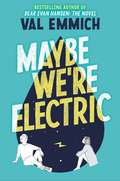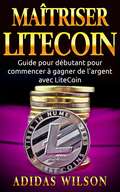- Table View
- List View
Mauerwerk Kalender 2018: Brücken, Bauen im Bestand (Mauerwerk-Kalender (VCH) *)
by Wolfram JägerProven and new: practical compendium for masonry for 40 years and counting: basics, examples, code commentaries - current and firsthand. Focus for 2018: Bridges, Rehablilitation
Mauerwerk Kalender 2019: Bemessung, Bauwerkserhaltung, Schallschutz (Mauerwerk-Kalender (VCH) *)
by Wolfram JägerSeveral chapters provide practical examples of methods for building maintenance and energy saving modernization. In addition, the book contains background knowledge and explanations for the design analysis of infill walls, grouted anchors and compression strength of masonry.
Mauerwerk-Kalender 2020: Schwerpunkte: Bauen im Bestand; Befestigungen; Lehmmauerwerk (Mauerwerk-Kalender (VCH) *)
by Wolfram Jäger DresdenDer Mauerwerksbau ist mit rund 73 % Marktanteil der Wandbaustoff Nummer 1 im Wohnungsbau in Deutschland. In seinem 45. Jahrgang begleitet der Mauerwerk-Kalender diese erfolgreiche Bauart als verlässliches Nachschlagewerk mit den Eigenschaftswerten von Mauersteinen, Mauermörtel, Mauerwerk und Putzen, mit der aktuellen Übersicht über die allgemeinen bauaufsichtlichen Zulassungen bzw. allgemeinen Bauartgenehmigungen dieses Fachgebietes und mit der Zusammenstellung der geltenden technischen Regeln für den Mauerwerksbau. In diesem Zusammenhang wird in einem gesonderten Kapitel das neue Bauordnungsrecht vorgestellt. Für die richtige Bemessung von Befestigungen wird das notwendige Hintergrundwissen über die Ermittlung der Tragfähigkeit von Dübeln durch Versuche am Bauwerk dargestellt. Die Bauwerkssicherung mit dem Ziel der Sanierung und Erhaltung spielt im Mauerwerksbau eine wichtige Rolle. Daher werden die Verstärkung von aussteifenden Mauerwerkswänden in Erdbebengebieten und Mauerwerksverfestigungen zur Ertüchtigung der Standsicherheit dargestellt und erläutert. Ein aktueller Beitrag in der Rubrik Bauphysik gibt praxisnahe Hinweise zum Schlagregenschutz von Außenwänden nach DIN 4108-3.
Mauerwerk-Kalender 2021: Schwerpunkte: Kunststoffverankerungen, Digitalisierung im Mauerwerksbau (Mauerwerk-Kalender (VCH) *)
by Ernst & SohnIn seinem 46. Jahrgang begleitet der Mauerwerk-Kalender die erfolgreiche Bauart als verlässliches Nachschlagewerk mit den Eigenschaftswerten von Mauersteinen, Mauermörtel, Mauerwerk und Putzen, mit der aktuellen Übersicht über die allgemeinen bauaufsichtlichen Zulassungen bzw. allgemeinen Bauartgenehmigungen dieses Fachgebietes und mit der Zusammenstellung der geltenden technischen Regeln für den Mauerwerksbau. In diesem Zusammenhang wird in einem gesonderten Kapitel auf die Besonderheiten bei bauhabenbezogenen Bauartgenehmigungen (Zustimmungen im Einzelfall) eingegangen. Zwei weitere Beiträge widmen sich der Bemessung von Mauerwerkskonstruktionen. Hierin werden Tragfähigkeitstafeln zur vereinfachten Bemessung unbewehrten Mauerwerks und der Beitrag zur Erdbebenbemessung von Mauerwerksbauten aus dem Jahre 2010 wurde vollständig überarbeitet und aktualisiert. In einem Praxisbeitrag werden die Aspekte bei Planung und Ausführung von umfangsreichen Eingriffen in die Tragstrukturen von historischen Mauerwerksgewölben in einer denkmalgeschützten Festungsanlage vorgestellt. Für die richtige Bemessung von Befestigungen wird das notwendige Hintergrundwissen über die Ermittlung der Tragfähigkeit von Kunststoff- und Injektionsdübeln durch Versuche am Bauwerk dargestellt sowie auf die DIBt Richtlinien zur praxisbezogenen Anwendung eingegangen. Weitere Beiträge widmen sich dem Bau mit Fertigteilen sowie der Digitalisierung und den daraus resultierenden Herausforderungen aus der Sicht eines Baustoffherstellers sowie innovativen Entwicklungen wie dem 3D-Druck und der Robotik im Mauerwerksbau. Über den Einsatz eines neu entwickelten reversiblen Wandsystems aus mörtellos verlegten Betonhohlblocksteinen für sog. informelle Siedlungen berichtet ein Autorenteam.
Mauerwerk-Kalender 2022: Fassadengestaltung, Bauphysik, Innovationen (Mauerwerk-Kalender)
by Detleff Schermer Eric BrehmIn seinem 47. Jahrgang begleitet der Mauerwerk-Kalender die erfolgreiche Bauart als verlässliches Nachschlagewerk mit den Eigenschaftswerten von Mauersteinen, Mauermörtel, Mauerwerk und Putzen, mit der aktuellen Übersicht über die allgemeinen bauaufsichtlichen Zulassungen bzw. allgemeinen Bauartgenehmigungen dieses Fachgebietes und mit der Zusammenstellung der geltenden technischen Regeln für den Mauerwerksbau. In diesem Zusammenhang wird in einem gesonderten Kapitel auf die Besonderheiten bei bauvorhabenbezogenen Bauartgenehmigungen (Zustimmungen im Einzelfall) eingegangen. Mauerwerk bietet hervorragende Möglichkeiten zur Gestaltung, was ausführlich in einem Beitrag zur Fassadengestaltung bei Sichtmauerwerk herausgearbeitet wird. Weitere Beiträge beschäftigen sich mit bauphysikalischen Themen, wie der Energieeffizienz von Gebäuden nach GEG, dem aktuellen Stand der Planung von schallschutzgerechten Konstruktionen in Mauerwerk auf Basis von DIN 4109 und dem Erschütterungsschutz. Auch die Untersuchung und der Umgang mit Bestandsbauwerken wird behandelt in Beiträgen zur Ermittlung der Druckfestigkeit an bestehendem Mauerwerk und der Nachrechnung von Gewölbebrücken nach der Nachrechnungsrichtlinie für Straßenbrücken. Auch Innovationen im Mauerwerksbau werden in Beiträgen behandelt, die sich mit der digitalen Transformation, großformatigen und bewehrten Porenbetonelementen sowie generellen Innovation im Ziegelmauerwerksbau befassen.
Mauerwerk-Kalender 2023: Schwerpunkte: Instandsetzung - Erdbeben - Lehmbau (Mauerwerk-Kalender)
by Detleff SchermerIn seinem 48. Jahrgang begleitet der Mauerwerk-Kalender die erfolgreiche Bauart als verlässliches Nachschlagewerk mit den Eigenschaftswerten von Mauersteinen, Mauermörtel, Mauerwerk und Putzen, mit der aktuellen Übersicht über die Allgemeinen Bauaufsichtlichen Zulassungen bzw. Allgemeinen Bauartgenehmigungen dieses Fachgebietes und mit der Zusammenstellung der geltenden technischen Regeln für den Mauerwerksbau. In diesem Zusammenhang wird in einem gesonderten Kapitel auf die Besonderheiten bei Vorhabenbezogenen Bauartgenehmigungen (frühere Bezeichnung: Zustimmungen im Einzelfall) eingegangen. Ein Schwerpunkt des diesjährigen Kalenders ist der Lehmbau. In mehreren Beiträgen wird ausführlich auf die Grundlagen für die Bemessung von Lehmsteinmauerwerk und den aktuellen Stand der Regelwerke eingegangen. Abgerundet wird das Thema mit einem Projektbeispiel anhand der Konservierung von mesopotamischen Lehmsteinbauten in Uruk. Weitere Beiträge beschäftigen sich mit dem Erdbebennachweis von Mauerwerksbauten nach der aktuellen DIN EN 1998-1, der Brandschutzbemessung von Mauerwerkskonstruktionen nach Eurocode 6 sowie dem Denkmalschutz bei der Mauerwerksinstandsetzung. Ein Fortsetzungsbeitrag behandelt die Ertüchtigung und Erweiterung von Eisenbahngewölbebrücken. Im Rahmen der digitalen Transformation des Bauwesens behandelt ein weiterer Beitrag die Grundlagen künstlicher Intelligenz und deren Anwendung im Wohnungsbau. Das abschließende Kapitel gibt eine Übersicht zu laufenden Forschungsvorhaben im Mauerwerksbau.
Mauerwerk-Kalender 2024: Schwerpunkte (Mauerwerk-Kalender)
by Detleff Schermer Eric BrehmIn seinem 49. Jahrgang begleitet der Mauerwerk-Kalender die erfolgreiche Bauart als verlässliches Nachschlagewerk mit den Eigenschaftswerten von Mauersteinen, Mauermörtel, Mauerwerk und Putzen, mit der aktuellen Übersicht über die Allgemeinen Bauaufsichtlichen Zulassungen bzw. Allgemeinen Bauartgenehmigungen dieses Fachgebietes und mit der Zusammenstellung der geltenden technischen Regeln für den Mauerwerksbau. Ein Schwerpunkt des diesjährigen Kalenders ist das klimaeffiziente und nachhaltige Bauen mit Mauerwerk. In mehreren Beiträgen wird ausführlich auf Methoden zur Erreichung von Klimaneutralität in den Baustoffen eingegangen. Zusätzlich werden die Ergebnisse der Meta-Studie zusammengefasst und die Ansätze zur Berücksichtigung der Recarbonatisierung von zement- und kalkgebundenen Mauersteinen erläutert. Im Rahmen der Nachhaltigkeitsdebatte spielt auch die Kosteneffizienz eine maßgebende Rolle. Wie kostenoptimiertes Bauen funktionieren kann, wird ebenfalls in einem umfassenden Beitrag erläutert. Den wesentlichen Schwerpunkt in dieser Ausgabe bildet die Befestigungstechnik. In zwei ausführlichen Beiträgen wird nicht nur der Stand der Technik wiedergegeben, sondern sich auch dem komplexen Thema der Befestigung von absturzsichernden Fenstern angenommen. Weitere Beiträge beschäftigen sich mit der Bestandsanalyse und Sanierungskonzepten für bestehende Konstruktionen. Abgerundet wird dieser Teil durch ein hochaktuelles Projektbeispiel. Das abschließende Kapitel gibt eine Übersicht zu laufenden Forschungsvorhaben im Mauerwerksbau.
Mauerwerk-Kalender 2025 - Schwerpunkte: Aspekte der Nachhaltigkeit (Mauerwerk-Kalender)
by Regensburg Detleff Schermer Karlsruhe Eric BrehmmSeit einem halben Jahrhundert begleitet der Mauerwerk-Kalender die erfolgreiche Bauweise. Der Jubiläumsband widmet sich ganz dem Thema des Nachhaltigkeit und ist weiterhin das verlässliche Nachschlagewerk mit den Eigenschaftswerten von Mauersteinen, Mauermörtel, Mauerwerk und Putzen, mit der aktuellen Übersicht über die Allgemeinen Bauaufsichtlichen Zulassungen bzw. Allgemeinen Bauartgenehmigungen dieses Fachgebietes und mit der Zusammenstellung der geltenden technischen Regeln für den Mauerwerksbau. Ein Schwerpunkt des diesjährigen Kalenders ist das klimaeffiziente und nachhaltige Bauen mit Mauerwerk. In mehreren Beiträgen wird ausführlich auf Methoden zur Erreichung von Klimaneutralität in den Baustoffen eingegangen. Dabei wird der Bogen von neuartigen Dämmstoffen bis hin zu innovativen Ansätzen im Entwurf nachhaltiger Gebäude geschlagen. Damit ist der vorliegende Band ein Werk, dass nicht nur für die mit Mauerwerk planenden Architekten und Ingenieure interessant ist, sondern generell Ansätze zur Erreichung möglichst nachhaltiger Gebäude liefert.
Mauerwerk: Bemessung nach DIN 1053-100 (Bauingenieur-Praxis #4)
by Gero Marzahn Wolfram JägerDesign calculations and dimensioning of masonry according to the partial safety factor concept is required by the new standard part DIN 1053-100. This book is an introduction for its practice with background information from first hand with numerous examples.
Max Einstein: Rebels With A Cause (Max Einstein #2)
by James Patterson Chris Grabenstein<P><P>Max Einstein is the first and only children's adventure series officially approved by the Albert Einstein Archives. Max Einstein's typical day is not your average 12-year-old's. <P><P>She...- TEACHES classes at a New York college- Dodges KIDNAPPING attempts with her best friends- Goes on SECRET MISSIONS for her billionaire boss- Has a MYSTERIOUS CONNECTION to Albert Einstein <P><P>Just a day in the life of the Change Makers Institute's top agent! What does an Irish town and a village in India have in common? A water crisis that only a group of kid geniuses can fix! Max and her CMI friends attempt to use their smarts to find solutions, but it's hard to save the world when you're trying not to be kidnapped! A greedy corporation with an eye on capturing Max seems to know their every move. It's almost like the bad guys have a spy inside the Change Makers... <P><P><b>A New York Times Bestseller</b>
Max Einstein: Saves the Future (Max Einstein #3)
by James Patterson Chris GrabensteinThe world's #1 bestselling author has teamed up with the world's most famous genius to entertain, educate and inspire a generation of kids--with the first and only kids' book series officially approved by the Albert Einstein Archives.Albert Einstein + James Patterson = A Must Read! Max is back with a thrilling new adventure that involves time travel, creepy bad guys, killer drones, and a shocking mystery about her past that she will stop at nothing to solve! Under constant danger of being kidnapped by the shadowy Corporation, Max is on the run from New York to London and beyond. But soon the call comes for the Change Maker kids' next mission: make sure no kid ever goes hungry again! If anyone can tackle a problem this big, Max and her genius friends can. But mysterious clues about her past keep distracting Max's focus. She always wanted to know who her parents were and why they abandoned her as a baby. If she manages to build a time machine, she could find them and get all the answers! What's more important - her past, or the future of the Change Makers?
Max Einstein: The Genius Experiment (Max Einstein #1)
by James Patterson Chris GrabensteinWhat Harry Potter did for magic, Max Einstein does for kids' imaginations! Max leads a group of kid geniuses in this #1 New York Times bestseller officially approved by the Albert Einstein archives.Max Einstein is not your typical genius. She . . .Hacks the computer system at NYU to attend classesBuilds inventions to help the homelessAnd talks to Albert Einstein! (Okay, that's just in her imagination)But everything changes when Max is recruited by a mysterious organization! Their mission: solve some of the world's toughest problems using science. She's helped by a diverse group of young geniuses from around the globe as they invent new ways to power the farthest reaches of the planet. But that's only if the sinister outfit known only as The Corporation doesn't get to her first . . .Max Einstein is a heroine for the modern age and will be looked up to by readers for generations to come."[A] fast-paced, science-filled caper." -- The Wall Street Journal
Max Planck (SparkNotes Biography Guide)
by SparkNotesMax Planck (SparkNotes Biography Guide) Making the reading experience fun! SparkNotes Biography Guides examine the lives of historical luminaries, from Alexander the Great to Virginia Woolf. Each biography guide includes:An examination of the historical context in which the person lived A summary of the person&’s life and achievements A glossary of important terms, people, and events An in-depth look at the key epochs in the person&’s career Study questions and essay topics A review test Suggestions for further reading Whether you&’re a student of history or just a student cramming for a history exam, SparkNotes Biography guides are a reliable, thorough, and readable resource.
Max Quick: The Pocket and the Pendant
by Mark Jeffrey“Jeffrey’s descriptions of how time has stopped will stop readers in their own tracks. Plenty of action-adventure appeal.” — Booklist“An imaginative addition to the middle-grade speculative adventure canon.” — Bulletin of the Center for Children’s Books“This fast-paced adventure…will keep readers turning the pages. The incorporation of figures from Sumerian mythology adds an interesting element that may appeal to fans of Rick Riordan’s “Percy Jackson” series.” — School Library Journal“Riveting. The Pocket and the Pendant is not what you expect, no matter what you expect.” — Scott Sigler, New York Times bestselling author“A fresh, fun and fascinating idea deftly brought to life. With all its deeply–felt adventure, Max Quick should quickly captivate young readers.” — James Jennewein and Tom S. Parker, authors of the RuneWarriors Trilogy“A wildly imaginative romp through the vagaries of time, Max Quick leads the reader on a high–speed tour of ancient myths, alien kingdoms and some books you can really throw yourself into. Terrific adventure at breakneck speed.” — Richard Newsome, author of The Billionaire’s Curse
Max and Kate: At the Planetarium
by Mick ManningDid you know you can explore space and visit the stars from right here on planet Earth? Follow along with Max and Kate as they visit a science museum and learn about the night sky.
Maximizing Value with Automation and Digital Transformation: A Realist's Guide
by John Smith Leslie P. Willcocks Matt Stanton John HindleThis book is an indispensable guide for executives, programme leaders, and business owners on maximising value from automation and digital transformation. It provides a real-world journey map of automation, from RPA through to intelligent automation, with a focus on practical strategy and management principles intended to help seize the trillions of dollars that are still being left on the table by companies that have not yet made this leap. Though grounded on the research and advisory work of the author team, this book offers clear eyed, easy to read advice for avoiding the ‘transformation bog’ where many organisations find themselves, struggling to maintain their strategy in an environment that feels increasingly dynamic and confusing. This book is not blinded by the brilliant new technology and hones in on what works and what distracts. It provides a total value of ownership framework for navigation and identifies seven core digital capabilities required for success. Ultimately a book for realists rather than digital idealists, it will be a vital resource for professionals who must chart a course to verifiable business performance improvement through digital enterprise empowerment amid often conflicting priorities.
Maximum Dissipation Non-Equilibrium Thermodynamics and its Geometric Structure
by Henry W. Haslach Jr.Maximum Dissipation: Non-Equilibrium Thermodynamics and its Geometric Structure explores the thermodynamics of non-equilibrium processes in materials. The book develops a general technique created in order to construct nonlinear evolution equations describing non-equilibrium processes, while also developing a geometric context for non-equilibrium thermodynamics. Solid materials are the main focus in this volume, but the construction is shown to also apply to fluids. This volume also: * Explains the theory behind thermodynamically-consistent construction of non-linear evolution equations for non-equilibrium processes * Provides a geometric setting for non-equilibrium thermodynamics through several standard models, which are defined as maximum dissipation processes * Emphasizes applications to the time-dependent modeling of soft biological tissue Maximum Dissipation: Non-Equilibrium Thermodynamics and its Geometric Structure will be valuable for researchers, engineers and graduate students in non-equilibrium thermodynamics and the mathematical modeling of material behavior.
Maximum Speed: The fastest machines on Earth! (Maximum Speed #5)
by Rob ColsonDiscover some of the fastest vehicles ever made! From deafening dragsters to a rocket car that is faster than the speed of sound, these are vehicles that push the extremes. Find out about the fastest cars on the planet, and learn what it takes to drive them to maximum speed. The book explores how cars and motorbikes have evolved over time, and how they're engineered for extreme performance. It features fantastic large photos of the vehicles and technical data to support the text and increase STEM learning. At the end of the book are several pages of fun quizzes and games, sure to engage the reader even further. Maximum Speed is the perfect introduction for future engineers and designers aged 9+, and petrolheads everywhere! Contents: The need for speed / Speed on four wheels / Official speed records / The Blue Birds / Jet cars / Speed in the sixties / Pioneering women / Breaking the sound barrier / Speed in the future / Top fuel dragsters / Track racing Formula 1 / Speed and endurance / Fastest cars on the road / Powered by the sun / Speed on two wheels / Official speed records / Grand Prix racing / Isle of Man TT race / Endurance racing / Road bikes / Dirt biking / Speedway racing / Stunt riders / Drag bikes / The streamliner battle / Extreme machines / Quiz time / Speed games / Get creative / Speed files / Glossary / Index
Maxine and the Greatest Garden Ever
by Ruth SpiroBest friends Maxine and Leo combine their maker and artistic skills to create (and save!) the ultimate garden in this empowering, STEM-focused picture bookAfter sketching and plotting and planting, Maxine and Leo know they've made The Greatest Garden Ever! But they're not the only ones who think so. Soon, all sorts of animals make their way in, munching on carrots and knocking over pots. When Leo and Maxine can't agree on a way to deter these unwelcome critters, it looks like there's more on the line than saving their garden--they just might need to save their friendship too.
Maxwell, Sutton and the Birth of Color Photography: A Binocular Study
by Jordi CatThis focused and incisive study reassesses the historic collaboration between James Clerk Maxwell and Thomas Sutton. It reveals that Maxwell and Sutton were closer to true partners than has commonly been assumed, and shows how their experiments illuminate the role of technology, representation, and participation in Maxwell's natural philosophy.
Maxwell´s Equations: From Current Density Distribution to the Radiation Field of the Hertzian Dipole
by Jürgen DonnevertThis book focuses on the derivation and solution of Maxwell’s equations. The stations along the way include the laws of potential and current density distribution, as well as the laws of electrostatics and stationary magnetic fields. The book is chiefly intended for students of electrical engineering, information technology, and physics; the goal is to prepare them for courses on Electromagnetic Field Theory (EFT). Building on what they have learned in advanced physics and mathematics courses at secondary school or technical college, it is intended to accompany university-level EFT courses. Particular importance is attached to detailed explanations in text form, combined with a wealth of illustrations. All formulas are derived step by step.
Maybe It's Me: On Being the Wrong Kind of Woman
by Eileen PollackScientist and author of The Only Woman in the Room explores her intelligence up against social inequality in this collection of personal essays.Eileen Pollack has always had a love-hate relationship with society&’s rules for women and girls—especially as they were laid out for her while growing up in 1960s upstate New York. In Maybe It&’s Me, she recounts her many trials, triumphs, and misadventures as a smart woman navigating a world that is only just learning to imagine equality between the sexes.With poignant humor and candid honesty, Pollack describes her journey from high school—where she wasn&’t allowed to take advanced courses in science or math because she was female—to earning a physics degree at Yale; a post-graduate summer in which she was shot at and kidnapped; and a theoretically equal marriage in which she was nonetheless expected to do all the housework and child-rearing, pay the taxes, and make sure the Roto-Rooter guy arrived on time. &“Maybe it&’s me&” is a thought all women have struggled with at one time or another. Pollack&’s autobiographical essays take us from intimate, humorous stories of innocent curiosity to the calculated meanness of tween girls, from the defensive strategies of threatened men to incisive examinations of how society got here. In the end, Pollack&’s message is one of human connection and tenacity along the unending search for love, acceptance, and equality.
Maybe We're Electric
by Val EmmichFrom Val Emmich, the bestselling author of Dear Evan Hansen: The Novel, comes a deeply affecting story of two teens who find themselves thrown together overnight during a snowstorm and discover a surprising connection—perfect for fans of Nina LaCour, David Arnold, and Robin Benway.Tegan Everly is quiet. Known around school simply as the girl with the hand, she's usually only her most outspoken self with her friend Neel, and right now they're not exactly talking. When Tegan is ambushed by her mom with a truth she can't face, she flees home in a snowstorm, finding refuge at a forgotten local attraction—the tiny Thomas Edison museum.She's not alone for long. In walks Mac Durant. Striking, magnetic, a gifted athlete, Mac Durant is the classmate adored by all. Tegan can't stand him. Even his name sounds fake. Except the Mac Durant she thinks she knows isn't the one before her now—this Mac is rattled and asking her for help.Over one unforgettable night spent consuming antique records and corner-shop provisions, Tegan and Mac cast aside their public personas and family pressures long enough to forge an unexpectedly charged bond and—in the very spot in New Jersey that inspired Edison's boldest creations—totally reinvent themselves. But could Tegan's most shameful secret destroy what they've built?Emotionally vivid and endlessly charming, Maybe We're Electric is an artfully woven meditation on how pain can connect us—we can carry it alone in darkness or share the burden and watch the world light up again.
Mayday Over Wichita: The Worst Military Aviation Disaster in Kansas History
by D. W. CarterThe little-known story of a major catastrophe in a 1960s African American community: A “commendable, if unsettling, account.” —Richard Kluger, Pulitzer Prize-winning author of Simple JusticeOn the cold Saturday morning of January 16, 1965, a U.S. Air Force KC-135 tanker carrying thirty-one thousand gallons of jet fuel crashed into a congested African American neighborhood in Wichita, Kansas. When the fire and destruction finally subsided, forty-seven people—mostly African American children—were dead or injured, homes were completely destroyed and numerous families were splintered. As shocking as it may sound, the event was seemingly omitted from the historical record for nearly fifty years. Now, historian D. W. Carter examines the myths and realities of the crash while providing new insights about the horrific four-minute flight that forever changed the history of Kansas.Includes photographs
Maîtriser LiteCoin: Guide pour débutant pour commencer à gagner de l'argent avec LiteCoin
by Essaid Bahri Adidas WilsonLitecoin a été fondé pour agir comme alternative au Bitcoin afin de remédier aux lacunes constatées dans le réseau Bitcoin— il a été conçu pour être « léger » et plus prolifique que Bitcoin.Litecoin a également un coût de paiement quasi nul et facilite les paiements presque quatre fois plus vite que Bitcoin.
